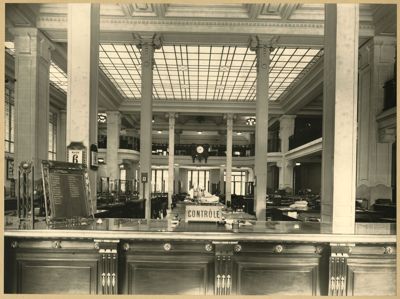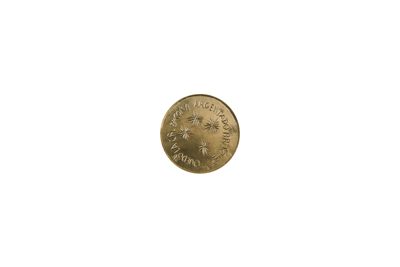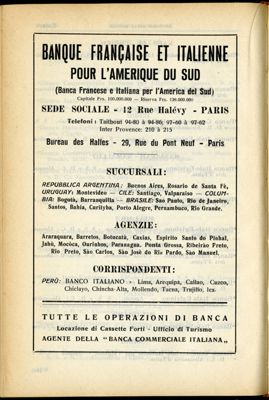| description |
Banque Française et Italienne pour l'Amérique du Sud (Sudameris) was founded in 1910. Its creation meant that France would have a bank supported by the numerous - and by then quite wealthy and influential - Italian émigré communities that had settled in South America, and Banca Commerciale Italiana (BCI), which was working to expand its operations in the region at the time, would have the support of the Parisian market. Thus Italian expatriate communities and French capital were the mainstays of the new bank.
Initially jointly owned by BCI (43.3%), Paribas (17.6%), Société Générale (13.2%) and others, following World War I the bank's controlling shareholder became BCI.
By 1939 Sudameris had branches in Brazil (São Paulo, Rio de Janeiro, Santos, Bahia, Curitiba, Porto Alegre and Recife, as well as 19 agencies in smaller areas), Argentina (Buenos Aires and Rosario de Santa Fe), Chile (Santiago and Valparaíso), Colombia (Bogotá, Barranquilla and Medellín), and Uruguay (Montevideo).
The events of World War II led to a period of organizational change for the bank, as well as the suspension of its activities on some markets. In the words of Giovanni Malagodi, then its general manager, BCI and Paribas had decided to "neutralize" Sudameris should war break out. To this end, in February 1940, the bank's general management - consisting of the Italian manager, a French co-manager and three Italian employees - was transferred from Paris to Buenos Aires, creating the Directorate-General for South American Countries (Direzione generale per i paesi sudamericani - DIGESUD). DIGESUD was able to operate thanks to a neutralization pact that guaranteed the bank's functioning and cooperation between its Italian and French staff, despite their being on opposite sides of the war. If it became necessary, the bank's South American branches were meant to act as an independent entity, based on the will of their managers to cooperate and the friendship and neutrality of their host countries. As of 10 June 1940, this is exactly how things went.
Following De Gaulle's freezing of Italian assets, the French government agreed in 1947 to renounce its right to reparations for war damages, provided that BCI kept less than half 50% of Sudameris shares, selling the rest to French shareholders. Banque dell'Indochine bought a stake in the bank, thereby becoming one of its shareholders. However, BCI managed to regain the majority of shares just a year later, thanks to UBS, which purchased a 10% stake on its behalf.
In 1948 Sudameris was able to resume its activities in Brazil after nearly seven years of inactivity.
In the aftermath of World War II Sudameris worked in Latin America through directly-owned branches or subsidiaries and member banks in Argentina, Brazil, Chile, Colombia, Uruguay and Venezuela, and later also in Paraguay.
In 1951, at the behest of Raffaele Mattioli, and with the agreement of the manager of Paribas and president of Sudameris, Henri Burnier, a voting trust was created between BCI and Paribas to protect 80% of Sudameris' capital as well as BCI's majority stake in the bank.
In December 1978 Banque Française & Italienne pour l'Amérique du Sud changed its name to Banque Sudameris S.A., while in France the Sudameris Group worked as a commercial bank through Banque Sudameris France S.A., which was created through the unification of Banca Commerciale Italiana (France), Crédit d'Escompte and Banque Française & Italienne pour l'Amérique du Sud's activities in the largest cities.
In 1979 the name "Sudameris" was chosen for all of the bank's South American subsidiaries - Banco Sudameris Brasil, Banco Sudameris Paraguay, Banco Sudameris International di Panama and so forth - and in that same year Banco Sudameris was reopened in Chile, in the capital city of Santiago. Banco Sudameris Colombia was created in 1982.
In the 1980s South America underwent a crisis that forced Sudameris to make several capital increases.
In 1994 BCI acquired 100% of the bank's shares and a year later Sudameris' 24 Argentinian branches were combined to create Banco Sudameris Argentina SA, a bank subject to local law that merged with Banco Caja de Ahorro in 2000.
In 1999 Sudameris went on to acquire Banco de Lima and Banco Wiese.
After BCI merged with Banca Intesa, a decision was made in 2002 to leave South America, selling all of the bank's subsidiaries there, and Sudameris became a finance company. Its liquidation was finalized in 2006 with the sale of its shares to Crédit Agricole. |
| BIBLIOGRAPHY |
ASI-BCI, VCA; February 28, 1910; vol. 3, pp. 13-15
ASI-BCI, Secretariat of managing directors Michelangelo Facconi and Raffaele Mattioli (AD 2), cart. 2
ASI-BCI, Sudameris
ASI-BCI, CM, Digesud, cart. 24
ASI-BCI, Financial Office |





